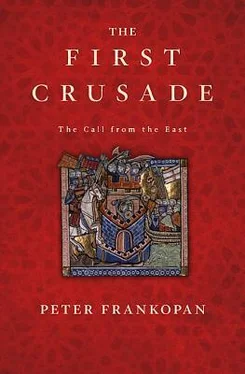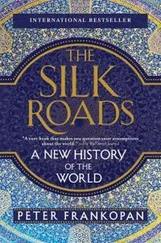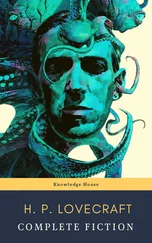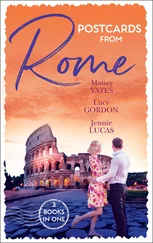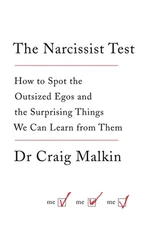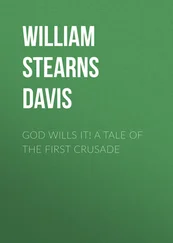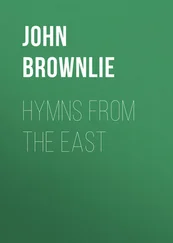The response to Urban’s speech was rapturous. Up went the cry: ‘ Deus vult! Deus vult! Deus vult! ’ – ‘God wills it! God wills it! God wills it!’ The crowd listened intently to hear what the Pope would say next. ‘Let that be a war-cry for you in battle because it came from God. When you mass together to attack the enemy, this cry sent by God will be the cry of all – “God wills it! God wills it!”’ 9
Many who heard the Pope’s speech were gripped by enthusiasm, hurrying home to begin preparations. Clerics dispersed to spread the word, while Urban undertook a gruelling schedule, criss-crossing France to promote the expedition, dispatching stirring letters to regions he did not have time to visit. Soon all of France was abuzz with crusading fever. Leading noblemen and knights hurried to join the expedition. Men like Raymond of Toulouse, one of the richest and most powerful figures in Europe, agreed to participate, as did Godfrey, Duke of Lorraine, who was so eager that before setting out, he minted coins bearing the legend ‘godefridus ierosolimitanus’ – ‘Godfrey the Jerusalem pilgrim’. 10News of the expedition to Jerusalem spread quickly and feverishly. 11The First Crusade was under way.
Four years later, in early July 1099, a battered, bedraggled yet supremely determined force of knights took up position by the walls of Jerusalem. The holiest location in Christendom was about to be attacked and seized from the Muslims. Siege engines had been built and were ready for action. Solemn prayers had been offered. The knights were about to achieve one of the most astonishing feats of endeavour in history.
The ambition of the First Crusade stemmed in part from the scale of the enterprise. In the past, armies had marched long distances and defied the odds to make sweeping conquests. The campaigns of the great generals of antiquity, such as Alexander the Great, Julius Caesar and Belisarius, showed how vast tracts of territory could be swallowed up by well-led, disciplined soldiers. What made the Crusade different was the fact that the western force was not an army of conquest but of liberation. At Clermont, Urban did not urge the knighthood of Europe to seize places as they journeyed east, benefiting from the resources of newly conquered towns and regions; rather, the aim was to free Jerusalem – and the churches of the east – from the oppression of the so-called pagans. 12
Things had not proved quite so simple, however. The journey across thousands of miles had brought terrible suffering and hardship, countless casualties and enormous sacrifice. Of the 70,000–80,000 soldiers of Christ who had responded to the Pope’s call, no more than a third reached Jerusalem. Urban’s envoy, travelling with the main Crusade leaders and writing back to Rome in the autumn of 1099, put the ratio of survivors to those lost in battle and disease well below this, suggesting that fewer than ten per cent of those who set out ever saw the walls of the Holy City. 13
Pontius Rainaud and his brother Peter, ‘most noble princes’, for example, were murdered by robbers after travelling from Provence through northern Italy and down the Dalmatian coast; they did not even make it halfway to Jerusalem. Walter of Verva got considerably further when he went out to forage for food one day with a band of fellow knights near Sidon (in modern Lebanon). He never came back. Perhaps he was ambushed and killed; maybe he was taken prisoner and sent as a captive deep into the bowels of the Muslim world, never to be heard of again; or perhaps his end was altogether more mundane: a missed step by a heavily laden horse on mountainous terrain could easily have fatal consequences. 14
There was Godevere, a noblewoman who chose to accompany her husband, Count Baldwin of Bouillon, on his journey east. She fell ill near Marash (in modern Turkey) and faded quickly, her condition worsening daily before she slipped away and died. This English-born aristocrat was laid to rest in an obscure and exotic corner of Asia Minor, far away from home, in a place her ancestors and kinsmen would never have heard of. 15
Then there were others, like Raimbold Cretons, a young knight from Chartres, who reached Jerusalem and took part in the assault on the city. He was the first knight to scale the ladders that had been placed against the walls, no doubt striving for the kudos heaped on the first man to break into the city. But Raimbold’s ascent had been watched by a defender of the fortifications who was no less eager, and who dealt him a blow that took one arm clean off and severed the other almost completely; Raimbold at least survived to witness the fall of Jerusalem. 16
And then there were the men whose mission ended in glory. The great leaders of the First Crusade – Bohemond, Raymond of Toulouse, Godfrey and Baldwin of Bouillon, Tancred and others – became household names all over Europe as a result of the capture of the Holy City. Their achievements were commemorated in countless histories, in verse and song, and in a new form of literature: medieval romance. Their success was to provide the benchmark for all later Crusades. It was a tough act to follow.
The First Crusade is one of the best-known and most written-about events in history. The story of knights taking up arms and crossing Europe to liberate Jerusalem enthralled writers at the time and has thrilled historians and readers ever since. Tales of astounding heroism, of the first encounters with the Muslim Turks, of the hardships suffered by the armed pilgrims on their journey east – ending with the bloody slaughter of the population of Jerusalem in 1099 – have echoed through western culture for nearly a thousand years. Imagery and themes from the Crusade proliferated in the music, literature and art of Europe. Even the word ‘Crusade’ itself – literally, the way of the Cross – came to take on a wider meaning: a dangerous but ultimately successful quest by the forces of good against evil.
The First Crusade captured the popular imagination because of its drama and violence. But it was not just theatre: the expedition has held its grip on the west because it shaped so much of what was to come: the rise of papal power, the confrontation between Christianity and Islam, the evolution of the concepts of holy war, knightly piety and religious devotion, the emergence of the Italian maritime states and the establishment of colonies in the Middle East. All had their roots in the First Crusade. 17
Not surprisingly, literature on the subject continues to flourish. Although generations of historians have written about the expedition, a remarkable school of modern scholars has produced outstanding and original work over the last few decades. Subjects such as the marching speed of the Crusader army, its provisioning and the coinage it used have been examined in detail. 18The interrelationship between the main narrative western sources has been looked at, recently provocatively so. 19In the past few years, attention has turned to understanding the apocalyptic backdrop to the expedition to Jerusalem and to the early medieval world in general. 20
Innovative approaches to the Crusade have been taken: psychoanalysts have suggested that the knights who went to Jerusalem were looking for an outlet to relieve pent-up sexual tension, while economists have examined supply/demand imbalances in the late eleventh century and explored the expedition in terms of the allocation of resources in early medieval Europe and the Mediterranean. 21Geneticists have assessed mitochondrial evidence from southern Anatolia in an effort to understand population movements in the late eleventh century. 22Others have pointed out that the period around the Crusade was the only time before the end of the twentieth century that GDP outstripped population growth, the implication being that there are parallels to be found between medieval and modern demographics and economic boom. 23
Читать дальше
